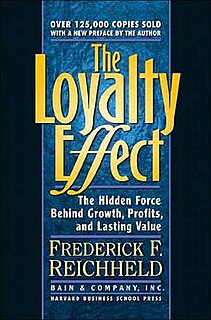Related Research Articles
In marketing, customer lifetime value, lifetime customer value (LCV), or life-time value (LTV) is a prognostication of the net profit contributed to the whole future relationship with a customer. The prediction model can have varying levels of sophistication and accuracy, ranging from a crude heuristic to the use of complex predictive analytics techniques.
The term "retention rate" is used in a variety of fields, including marketing, investing, education, in the workplace and in clinical trials. Maintaining retention in each of these fields often results in a positive outcome for the overall organization or school, or pharmacological study. In marketing, retention rate is used to count customers and track customer activity irrespective of the number of transactions made by each customer.
Customer service is the provision of service to customers before, during, and after a purchase. The perception of success of such interactions is dependent on employees "who can adjust themselves to the personality of the guest". Customer service concerns the priority an organization assigns to customer service relative to components such as product innovation and pricing. In this sense, an organization that values good customer service may spend more money on training employees than the average organization or may proactively interview customers for feedback.
The loyalty business model is a business model used in strategic management in which company resources are employed so as to increase the loyalty of customers and other stakeholders in the expectation that corporate objectives will be met or surpassed. A typical example of this type of model is: quality of product or service leads to customer satisfaction, which leads to customer loyalty, which leads to profitability.
Churn rate, in its broadest sense, is a measure of the number of individuals or items moving out of a collective group over a specific period. It is one of two primary factors that determine the steady-state level of customers a business will support.

The Loyalty Effect is a 1996 book by Fred Reichheld of the consulting firm Bain & Company, and the book's title is also sometimes used to refer to the broader loyalty business model as a whole. Reichheld's book was exceptionally popular with marketing and customer relationship management professionals, and as such the phrase "loyalty effect" has become synonymous in some circles with the more generic concepts covered by the loyalty business model.
Customer satisfaction is a term frequently used in marketing. It is a measure of how products and services supplied by a company meet or surpass customer expectation. Customer satisfaction is defined as "the number of customers, or percentage of total customers, whose reported experience with a firm, its products, or its services (ratings) exceeds specified satisfaction goals." Customers play an important role and are essential in keeping a product or service relevant; it is, therefore, in the best interest of the business to ensure customer satisfaction and build customer loyalty.

Frederick F. Reichheld is a New York Times best-selling author, speaker and business strategist best known for his research and writing on the loyalty business model and loyalty marketing. He is the creator of the Net Promoter System of management (NPS).
Customer retention refers to the ability of a company or product to retain its customers over some specified period. High customer retention means customers of the product or business tend to return to, continue to buy or in some other way not defect to another product or business, or to non-use entirely. Selling organizations generally attempt to reduce customer defections. Customer retention starts with the first contact an organization has with a customer and continues throughout the entire lifetime of a relationship and successful retention efforts take this entire lifecycle into account. A company's ability to attract and retain new customers is related not only to its product or services, but also to the way it services its existing customers, the value the customers actually perceive as a result of utilizing the solutions, and the reputation it creates within and across the marketplace.
Next-best-action marketing, as a special case of next-best-action decision-making, is a customer-centric marketing paradigm that considers the different actions that can be taken for a specific customer and decides on the ‘best’ one. The Next Best Action is determined by the customer's interests and needs on the one hand, and the marketing organization's business objectives, policies on the other. This is in sharp contrast to traditional marketing approaches that first create a proposition for a product or service and then attempt to find interested and eligible prospects for that proposition. This practice, direct marketing, typically automated in the form of a campaign management tool, is often product-centric, and usually always marketing-centric.
The Advocacy Index is a telephone based customer survey technique developed by VIRTUATel Ltd to measure the loyalty of a company's customers, using a 3-point scale and was based upon the Net Promoter Score (NPS) methodology, created by Fred Reichheld.

Active users is a measurement metric that is commonly used to measure the level of engagement for a particular product or object, by quantifying the number of active interactions from visitors within a relevant range of time . The metric has many uses in both commerce and academia, such as on social networking services, online games, or mobile apps. Although having extensive uses in digital behavioural learning, prediction and reporting, it also has impacts on the privacy and security, and ethical factors should be considered thoroughly. Like any metric, active users may have limitations and criticisms. Active Users is relatively new or neologistic in nature, that became important with the rise of the commercialised internet, with uses in communication and social-networking. It measures how many users visit or interact with the product or service over a given interval or period. This metric is commonly assessed per month as monthly active users (MAU), per week as weekly active users (WAU), per day as daily active users (DAU) or peak concurrent users (PCU).
Willingness to recommend is a metric related to customer satisfaction. When a customer is satisfied with a product, he or she might recommend it to friends, relatives and colleagues. This willingness to recommend can be a powerful marketing advantage. In a survey of nearly 200 senior marketing managers, 57 percent responded that they found the "willingness to recommend" metric very useful.
Customer delight is surprising a customer by exceeding his or her expectations and thus creating a positive emotional reaction. This emotional reaction leads to word of mouth. Customer delight directly affects sales and profitability of a company as it helps to distinguish the company and its products and services from the competition. In the past customer satisfaction has been seen as a key performance indicator. Customer satisfaction measures the extent to which the expectations of a customer are met. However, it has been discovered that mere customer satisfaction does not create brand loyalty nor does it encourage positive word of mouth.
Constituent Voice is a performance management and measurement method designed as a continual improvement process developed by Keystone Accountability to enable organisations addressing social issues to improve their results by improving relationships with their constituents. Like customer satisfaction measurement, which it draws from, Constituent Voice treats measurement as an aspect of an intervention that not only provides metrics but contributes directly to outcomes by increasing the engagement of intended beneficiaries.
EMO Index is a tool which aims to measure the feelings of a customer, a group of customers or stakeholders towards a company, product or service. It serves as an alternative to traditional customer satisfaction research.
Customer Success or Customer Success Management is the business method ensuring customers achieve success, their desired outcomes while using your product or service. Customer Success is relationship-focused client management, that aligns client and vendor goals for mutually beneficial outcomes. Effective Customer Success strategy typically results in decreased customer churn and increased up-sell opportunities. The goal of Customer Success is to make the customer as successful as possible, which in turn, improves customer lifetime value (CLTV) for the company.
Rob Markey is an American author, speaker, and business strategist. He is perhaps best known for his research and writing on customer experience and loyalty marketing. Markey is also the co-creator of the Net Promoter System of management (NPS), along with fellow Bain & Company consultant Fred Reichheld.
A feedback terminal is a physical device that is commonly used to collect large amounts of anonymous real-time feedback from customers, employees, travelers, visitors or students. Typically, feedback terminals feature buttons that users can press to indicate how satisfied they are with the service provided. This information can then used by organisations to analyze where the experience is optimal, and where it can be improved.
First Call Resolution or First Contact Resolution (FCR) is a metric used to measure customer inquiries or problems resolved on the first call or contact with a representative or agent. FCR is one of the most commonly measured metrics in the call center industry. Ideally, the FCR definition means no repeat calls or contacts are required from the initial call or contact reason from a customer perspective.
References
- 1 2 Reichheld, Frederick F. (December 2003). "One Number You Need to Grow". Harvard Business Review . PMID 14712543.
- 1 2 3 Colvin, Geoff (18 May 2020). "The simple metric that's taking over big business". Fortune. Retrieved 3 June 2020.
- ↑ "Measuring Your Net Promoter Score℠". Bain. Retrieved 13 February 2021.
- ↑ Burnham, Thomas A.; Jefferey A. Wong (2018). "Factors influencing successful net promoter score adoption by a nonprofit organization: a case study of the Boy Scouts of America". International Review on Public and Nonprofit Marketing.
- ↑ https://surveysparrow.com/blog/employee-nps-enps-guide
- ↑ Call Centers for Dummies, By Real Bergevin, Afshan Kinder, Winston Siegel, Bruce Simpson, p.345
- ↑ "Net Promoter Score - The Ultimate Guide | Feedough" . Retrieved 13 February 2021.
- ↑ jennymkaplan, Jennifer Kaplan. "The Inventor of Customer Satisfaction Surveys Is Sick of Them, Too". Bloomberg.com. Retrieved 5 June 2016.
- 1 2 3 4 Reichheld, Fred; Markey, Rob (2011). The Ultimate Question 2.0: How Net Promoter Companies Thrive in a Customer-Driven World. Boston, Mass.: Harvard Business Review Press. p. 52. ISBN 978-1-4221-7335-0.
- ↑ "The simple metric that's taking over big business". Fortune. Retrieved 6 February 2021.
- ↑ Markey, Rob; Reichheld, Fred. "The Economics of Loyalty". Loyalty Insights. Bain & Company, Inc. Retrieved 9 August 2015.
- ↑ "Maurice FitzGerald - Satmetrix". September 2015. Archived from the original on 18 December 2015. Retrieved 11 December 2015.
- ↑ Wierckx, Patrick J. (11 October 2020). "The Retention Rate Illusion - Understanding the Relationship between Retention Rates and the Strength of Subscription-Based Businesses". Journal of Applied Business and Economics. Rochester, NY.
- ↑ Sheehan, Kim Bartel (23 June 2006). "E-mail Survey Response Rates: A Review". Journal of Computer-Mediated Communication. 6 (2): 0–0. doi:10.1111/j.1083-6101.2001.tb00117.x. ISSN 1083-6101.
- ↑ "Physical measures and biomarker collection in health surveys: Propensity to participate". Research in Social and Administrative Pharmacy. 5 August 2020. doi: 10.1016/j.sapharm.2020.07.025 . ISSN 1551-7411.
- ↑ "Would You Recommend Us?" Business Week, 29 January 2006.
- ↑ Atilla Wohllebe; Florian Ross; Szilárd Podruzsik (November 2020). "Influence of the Net Promoter Score of Retailers on the Willingness of Consumers to Install Their Mobile App". International Journal of Interactive Mobile Technologies. 14 (19): 124–139. doi: 10.3991/ijim.v14i19.17027 .
- ↑ Timothy L. Keiningham; Bruce Cooil; Tor Wallin Andreassen; Lerzan Aksoy (July 2007). "A Longitudinal Examination of Net Promoter and Firm Revenue Growth" (PDF). Journal of Marketing . 71 (3): 39–51. doi:10.1509/jmkg.71.3.39. S2CID 54726616. Archived from the original (PDF) on 16 July 2020.
- ↑ Hayes (2008), "The True Test of Loyalty," Quality Progress, June 2008, 20–26.
- ↑ Preston, Carolyn C.; Colman, Andrew M. (14 September 1999). "Optimal number of response categories in rating scales: reliability, validity, discriminating power, and respondent preferences" (PDF). Acta Psychologica. 104: 1–15. doi:10.1016/s0001-6918(99)00050-5. hdl:2381/3937. PMID 10769936.